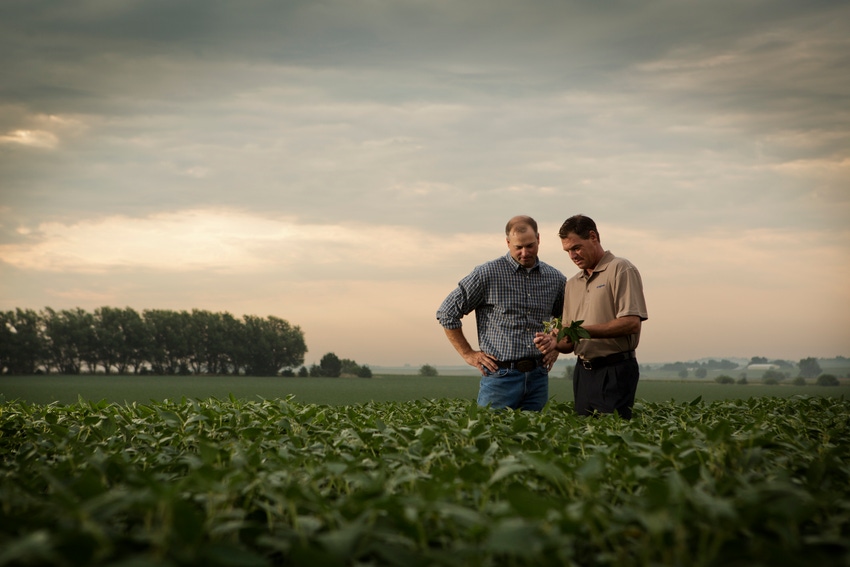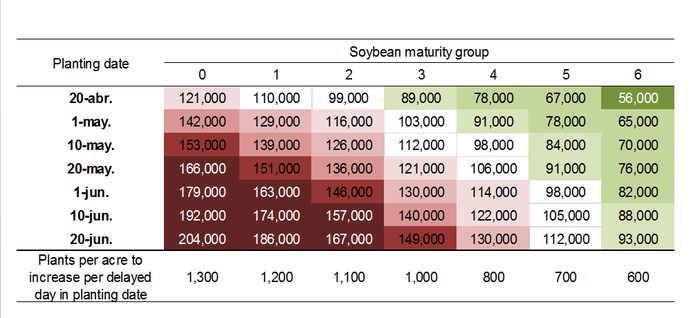May 5, 2017

(In this three-part series, Syngenta global head of soybean breeding Joseph Byrum shares the results of a big data analysis of more than 400 research experiments on plant populations and soybean yields, published in scientific journals. The goal was to find the optimum plant density given different planting dates and varietal maturities, so growers can increase their probability of success and profit). Check out parts one and two here.
As we discussed in Parts I and II of this series, the most economical approach to soybean production is to grow a smaller number of large plants to save on input costs. The trick is to know the absolute minimum number of plants needed to reach maximum yield. Studies show that as long as the plants have enough leaf area to absorb 95 percent of the solar radiation from the pod formation stage, they will achieve maximum growth.
We examined the factors that scientific research has shown has the most influence on plant density: location, planting date and maturity group. While looking at these factors in isolation is good for understanding the biological causes underlying soybean plant population needs, these factors are never seen in isolation in the real world. All of these factors interact with one another, which makes it more complex to zero in on the optimal plant density for a given situation.
To examine the interplay of the main factors that affect plant density, let’s consider the case of a farmer who is doing everything right,. The plants have everything they need — great weather, nutrients and the field is clear of weeds, insects and disease. In such ideal circumstances, the choice of planting date is the one factor that places a hard limit on the yield that can be achieved. Plant late, and yield will drop. Plant early, and greater yields are possible.
So if a farmer faces a planting delay, he might compensate for the shortened crop cycle duration by increasing the maturity group. To see what effect this has, the results from scientific research studies were examined with planting dates from April 20 through June 20 and maturity groups from 0 to VI.
Delayed planting increases seeding rate
The data show that if planting is delayed in short maturity groups, growers will need more seeds to compensate than would have been required in the long maturity groups. For instance, a group 0 crop planted on April 20 would require a density of 121,000 plants per acre, while an extra 21,000 plants would be needed if planting were delayed to May 1. The difference in a group VI crop, however, would be just 9,000 plants per acre. The delay in planting, on average, costs 1,300 plants per day in maturity group 0 compared to 600 plants per day in maturity group VI.
These results are driven by plant biology. When seeds are planted later in the season to suit environmental conditions, the crop develops at a faster pace. The growth cycle takes place within a shortened window, leaving less time for growth. That means the plants are smaller, and the leaves have a reduced capacity to absorb light. Throw in short maturity group cultivars, and the effects are multiplied.
To compensate for the reduced leaf area from the later planting of short maturity groups, you need greater plant density. More plants are needed to achieve the canopy coverage able to absorb the light needed for maximum yield.
Alter varietal maturity
We can also draw some practical advice for economizing from these results. Since more than one maturity group can work in a given location, growers can consider adjusting the maturity group selection to the longest group adapted for the location. This would reduce the density requirement without impacting yield. If, for example, group I and group II are recommended options for a particular latitude, going with the group II option could result in cutting the density by 40,000 plants, while still enjoying the best possible yield.
Overall, the analysis of scientific studies show that the optimal plant population can be as low as 56,000 for Group VI soybean planted on April 20 or as high as 204,000 for Group 0 soybean planted on June 20. Adjusting seeding rates to the optimal level is a great way to save money.
Table 1. Plant population per acre required to maximize yield across planting dates and maturity groups. The general recommendation from the meta-analysis of published scientific articles was 104,000 plants per acre. Cell colors indicates departure for this general recommendation. Increasing red intensity indicates plant populations higher than the general recommendation. Increasing green intensity indicates plant populations lower that the general recommendation.

So there’s a financial reason to consider precision soy strategies that bring plant populations down without sacrificing yield. The more farmers are willing to arm themselves with data and science, the more likely it is that they can dial in the right plant population, boosting the return on their investment. It’s hard to overstate the importance of seeking solid, data-backed agronomic advice for achieving the best results with soybean.

In case you missed it, check out parts one and part two here.
About the Author(s)
You May Also Like






